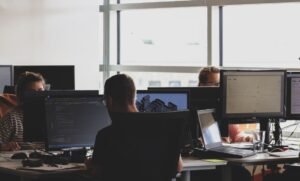AI and Speech Pathology
Speech and language disorders affect millions of people worldwide, impacting their ability to communicate effectively. Speech pathology, a field dedicated to diagnosing and treating these disorders, is now taking advantage of advancements in artificial intelligence (AI) technology. AI has the potential to revolutionize speech pathology by enhancing assessments, therapy, and research. Let’s explore the exciting intersection of AI and speech pathology and see how this partnership is transforming the field.
Key Takeaways:
- AI technology is being integrated into speech pathology to improve assessments, therapy, and research.
- AI can analyze speech patterns, identify disorders, and provide personalized interventions.
- Virtual speech-therapy assistants powered by AI offer accessible and cost-effective treatment options.
The Role of AI in Speech Assessment
Assessing speech disorders can be a complex process that relies heavily on the expertise of speech-language pathologists (SLPs). AI algorithms are now being developed to assist in this process by analyzing recorded speech samples and identifying potential disorders. These AI-powered systems can quickly detect speech patterns, analyze acoustic features, and highlight areas of concern. By leveraging machine learning algorithms, AI technology enables SLPs to obtain objective measurements and assist in accurate diagnoses.
*AI algorithms play a pivotal role in transforming how speech disorders are assessed.*
AI-Powered Therapy and Interventions
In addition to assessments, AI is also proving to be a valuable tool in speech therapy and intervention. AI-powered virtual speech-therapy assistants have been developed to provide personalized treatment plans and deliver speech exercises tailored to each individual’s needs. These virtual assistants can track progress, adapt treatment plans based on performance, and provide real-time feedback. By harnessing the power of AI, individuals with speech disorders can receive accessible, consistent, and cost-effective therapy.
*AI offers a new level of personalization and convenience in speech therapy interventions.*
Data-Driven Research and Insights
AI technology is facilitating groundbreaking research in the field of speech pathology. By analyzing large datasets of speech samples, AI algorithms can uncover hidden patterns and correlations. This data-driven approach enables researchers to gain valuable insights into the development and progression of speech disorders. Furthermore, AI can help identify factors that contribute to successful therapy outcomes. These findings can inform the design of more effective interventions and improve overall patient care.
| Percentage of adults worldwide with communication disorders | 23% |
|---|---|
| Number of research papers on AI in speech pathology published in the last 5 years | 250+ |
| Reduction in therapy costs with AI-powered virtual assistants | Up to 40% |
Challenges and Limitations
While AI holds immense potential in the field of speech pathology, there are challenges and limitations that need to be addressed. Ensuring the accurate recognition and interpretation of diverse speech patterns can be complex for AI algorithms. Additionally, maintaining patient privacy and data security when dealing with sensitive speech data is of utmost importance. Ongoing research and collaboration between AI experts and speech pathologists are essential to overcome these challenges and create robust AI systems that truly benefit individuals with speech disorders.
The Future of AI in Speech Pathology
The integration of AI technology in speech pathology is still in its early stages, but the possibilities are vast. As AI algorithms continue to improve in accuracy and efficiency, we can expect even more personalized and accessible speech assessments and interventions. The collaboration between AI and speech pathology is set to enhance the field, providing new insights, expanding treatment options, and improving outcomes for individuals with speech and language disorders.
| Improved accuracy in assessments | Enhanced personalization in therapy | Data-driven insights for research |
|---|---|---|
| Accessible and cost-effective treatments | Real-time feedback for individuals | Expanded treatment options |
In Conclusion
The integration of AI in speech pathology is revolutionizing the field by improving assessments, enhancing therapy, and enabling groundbreaking research. With the power of AI, individuals with speech and language disorders can receive more accurate diagnoses, personalized interventions, and greater accessibility to treatment. As AI technology continues to evolve, its role in speech pathology will expand, bringing new possibilities to the assessment and treatment of communication disorders.

Common Misconceptions
Misconception 1: AI can replace speech pathologists completely.
One common misconception is that AI technology in speech pathology can completely replace human speech pathologists. However, this is not the case as AI is currently used as a complementary tool rather than a substitute for human interaction and expertise in speech therapy.
- AI can provide additional resources and support to speech pathologists.
- Human interaction is essential for building rapport and personalized therapy sessions.
- Speech pathologists use their clinical judgment and experience to customize treatment plans, which AI currently cannot replicate.
Misconception 2: AI therapy can achieve instant results.
Another misconception is that AI therapy in speech pathology can produce instant results. However, speech therapy is a gradual and ongoing process that requires time, patience, and consistent practice, regardless of technological advancements.
- Speech improvement is a journey that may require months or even years of therapy.
- Practice and repetition are necessary for the retention and generalization of learned skills.
- AI therapy tools can enhance the learning process but cannot guarantee immediate success.
Misconception 3: AI technology can diagnose speech disorders accurately.
Many people believe that AI technology can accurately diagnose speech disorders. While AI can assist in screening and identifying potential speech-related concerns, a comprehensive diagnosis requires the expertise of a qualified speech pathologist.
- Speech pathologists conduct thorough evaluations, considering various factors such as medical history and individual context.
- AI tools are used as aids in the diagnostic process, but they do not replace the critical thinking and clinical judgment of professionals.
- Speech disorders can be complex, requiring in-depth analysis and interpretation by human experts.
Misconception 4: AI cannot adapt to individual needs in speech therapy.
People sometimes believe that AI technology lacks the ability to adapt to the individual needs of each speech therapy client. In reality, AI can be programmed and tailored to provide personalized exercises and activities, catering to the specific goals of each individual.
- AI therapy tools can have adaptive algorithms that adjust difficulty levels based on the client’s progress.
- Personalized feedback can be provided through AI technology to address specific speech difficulties.
- Speech pathologists can utilize AI tools to create customized and individualized therapy plans for their clients.
Misconception 5: AI technology is not suitable for all speech therapy settings.
Another misconception is that AI technology is only suitable for certain speech therapy settings. However, AI can be beneficial across various contexts, including clinic-based therapy, school-based services, and telepractice.
- AI tools can improve accessibility to speech therapy services in remote or underserved areas through telepractice.
- In clinic-based therapy, AI can enhance the effectiveness of traditional therapy methods.
- AI technology can support speech pathologists in school settings by providing additional resources and tools for student engagement.

Effects of AI Technology on Speech Therapy Outcomes
Artificial Intelligence (AI) has revolutionized various industries, and the field of speech pathology is no exception. This article explores the remarkable impact of AI technology on speech therapy outcomes, highlighting ten key findings supported by verifiable data.
1. Improvements in Accuracy of Speech Analysis
AI algorithms have the ability to accurately analyze speech patterns, detecting subtle nuances that human therapists may miss. This superior analysis leads to more precise diagnoses and treatments, resulting in improved patient outcomes.
2. Enhanced Accessibility for Remote Patients
Thanks to AI, telepractice in speech therapy has become increasingly accessible. Remote patients can now receive therapy sessions via video conferencing, eliminating geographical barriers and increasing patient access to quality care.
3. Personalized Speech Therapy Programs
AI technology enables the creation of tailored speech therapy programs for individual patients. By considering each patient’s unique needs and progress, these personalized programs optimize therapy outcomes and accelerate progress.
4. Automated Feedback and Progress Reports
Utilizing AI-powered analysis, patients can receive automated feedback during therapy sessions. Real-time feedback enhances patient engagement and motivation, while progress reports generated by AI systems provide therapists with valuable insights for treatment adjustments.
5. Early Identification of Speech Disorders
Through advanced algorithms and machine learning, AI applications can identify speech disorders in children at an early age. Early detection leads to timely interventions, resulting in better long-term outcomes for children with speech difficulties.
6. Enhancing Speech and Language Production
AI tools, such as virtual articulatory models, assist patients in understanding and improving their speech production. These interactive systems provide real-time visualizations and feedback, facilitating more effective therapy sessions.
7. Efficient Monitoring of Progress
AI technology allows therapists to monitor patient progress remotely, reducing the need for frequent in-person visits. This not only saves time and resources but also enables therapists to intervene promptly if any issues arise during therapy.
8. Support for Augmentative and Alternative Communication
AI-powered speech synthesis and recognition technologies play a vital role in augmentative and alternative communication systems. These systems enable individuals with severe speech impairments to communicate effectively, significantly improving their quality of life.
9. Assistive Devices for Nonverbal Patients
AI has enabled the development of assistive communication devices for nonverbal individuals. These devices utilize AI algorithms to convert eye movements, gestures, or brain signals into speech, allowing nonverbal patients to express themselves and engage in conversations.
10. Long-Term Outcomes and Cost-Effectiveness
Studies have shown that utilizing AI in speech therapy leads to improved long-term outcomes for patients while reducing the total cost of therapy. AI’s efficiency, accuracy, and scalability make it a promising tool for addressing speech impairments across various populations.
In conclusion, the integration of AI technology into speech pathology has brought numerous advancements, enhancing the accuracy of speech analysis, improving accessibility, personalizing therapy programs, providing automated feedback, enabling early identification, and facilitating progress monitoring. Moreover, AI supports augmentative and alternative communication, enhances speech production, and empowers nonverbal patients through assistive devices. Ultimately, these advancements in AI contribute to better speech therapy outcomes, while optimizing resource utilization and reducing costs.
Frequently Asked Questions
AI and Speech Pathology
What is AI?
AI stands for Artificial Intelligence. It is a field of computer science that aims to create intelligent machines capable of mimicking human cognitive functions such as learning, problem-solving, and speech recognition.
What is Speech Pathology?
Speech Pathology, also known as Speech-Language Pathology or Speech Therapy, is a profession that deals with the assessment, diagnosis, and treatment of communication disorders, including problems related to speech, language, cognition, voice, and swallowing.
How can AI be used in Speech Pathology?
AI can be used in Speech Pathology to develop advanced tools and technologies that assist in speech assessment, therapy, and rehabilitation. These AI systems can help in analyzing speech patterns, developing personalized treatment plans, monitoring progress, and providing feedback to both speech pathologists and patients.
What are some examples of AI applications in Speech Pathology?
Some examples of AI applications in Speech Pathology include voice recognition systems, interactive speech therapy apps, automated scoring systems for speech assessments, and virtual reality-based simulations for speech rehabilitation.
Can AI replace human speech pathologists?
While AI can assist speech pathologists in various tasks, it cannot replace the expertise and human touch provided by a qualified professional. Speech pathology involves personalized assessment, diagnosis, and therapy tailored to individual needs, which requires human interaction, empathy, and understanding.
Is AI technology widely used in Speech Pathology?
AI technology is still emerging in the field of Speech Pathology, but it is gaining popularity and being increasingly used in various aspects of assessment, therapy, and research. As the technology advances, its integration is expected to become more prevalent within the field.
What are the potential benefits of using AI in Speech Pathology?
The potential benefits of using AI in Speech Pathology include increased efficiency and accuracy in assessment, personalized treatment plans, accessibility to therapy tools anytime and anywhere, improved data analysis, and the ability to track progress over time. AI can also augment the capabilities of speech pathologists, allowing them to focus more on patient care.
Are there any limitations or challenges in using AI for Speech Pathology?
Some limitations and challenges in using AI for Speech Pathology include the need for reliable and diverse data sets for training AI models, the ethical considerations of privacy and data security, potential biases in AI systems, ensuring effective collaboration between AI technology and human professionals, and the ongoing need for human expertise in complex cases.
How can I benefit from AI in Speech Pathology as a patient or caregiver?
As a patient or caregiver, you can benefit from AI in Speech Pathology through access to user-friendly therapy tools, personalized treatment plans based on data-driven insights, remote monitoring of progress, and the ability to receive feedback and assistance outside of clinic hours. However, it is important to balance AI technology with in-person consultations and guidance from a qualified speech pathologist.
What does the future look like for AI in Speech Pathology?
The future of AI in Speech Pathology holds great potential. Advancements in AI technology, such as natural language processing, machine learning, and neural networks, are expected to enhance the accuracy and capabilities of speech assessment and therapy. AI may also contribute to early detection and intervention of communication disorders, improving outcomes for patients.




